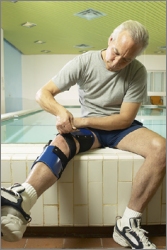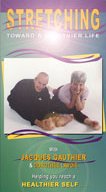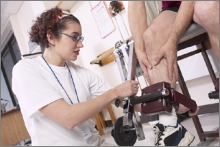5 Common Knee Problems and How to Prevent and Treat Them
by www.SixWise.com
Knee pain sends many Americans to the doctor's office every year. In fact, nearly half of Americans (47 percent) experienced knee (or lower back) pain in the past year, according to a survey by Dr. Scholl's.
|

Nearly half of Americans experienced knee or back pain in the last year.
|
Typically, knee pain is either the result of an injury or a chronic condition, both of which can cause debilitating pain in one of the most important joints in your body. Although not all knee pain is serious, some knee pain can signal conditions that, if left untreated, may lead to joint damage or even disability. Meanwhile, once you have a knee injury there's a greater chance you'll experience another one in the future.
Fortunately, there are ways you can help protect your knees and recover from any knee pain you may be experiencing. Following are five of the most common problems to impact the knees.
1. Patellofemoral Pain Syndrome (Runner's Knee)
The pain associated with patellofemoral pain syndrome occurs on and around your kneecap. Common in girls and women aged 10-20 and people involved in sports, this condition occurs when your kneecap does not move in the correct motion when your knee is bent (such as while running). Over time, the movement leads to damage of the surrounding tissues and eventually pain.
|
Learn the 15 Most Effective Stretches, and All the Tips to Stretch Properly, in this Highly Acclaimed DVD by Jacques Gauthier!
FREE SHIPPING ANYWHERE for a Limited Time!
 "Without a doubt, the simple stretching exercises on this DVD will add life to your years ... and years to your life!" "Without a doubt, the simple stretching exercises on this DVD will add life to your years ... and years to your life!"
-- Dr. Jean Chevrefils
- The Most Effective 15 Stretching Exercises
- Works Almost 100% of ALL Muscles in Your Body
- Full Program Takes Just 15-20 Minutes Per Day
- Eliminate Pain
- Feel Much Younger & Energetic
- Increase Your Mental Clarity and Focus
- Improve Your Blood & Oxygen Circulation
- Improve Your Body's Absorption of Nutrients
- Slow Degeneration of Your Joints
- Dramatically Improve the Way Your Body Looks!
Read More About the Stretching DVD & Order Now
|
Causes of patellofemoral pain syndrome include:
-
Malalignment of the kneecap
-
Complete or partial dislocation
-
Injury
-
Excessive training or overuse
-
Tightness, imbalance, or weakness of thigh muscles
-
Flat feet
To help prevent this condition:
-
Maintain a healthy weight (excess weight puts stress on your knees)
-
Stretch. After warming up for five minutes, stretch your legs thoroughly.
-
Increase the intensity your sports activities or workouts gradually.
-
Use proper sports gear (such as running shoes with a lot of shock absorption) and form.
Treating runner's knee involves the RICE formula:
-
Rest your knee.
-
Ice. Apply an ice pack wrapped in a towel for a few minutes several times a day.
-
Compression. Put an elastic bandage or knee sleeve with the kneecap cut out around your knee.
-
Elevation. Raise your knee higher than your heart.
2. Prepatellar Bursitis (Housemaid's Knee)
This condition can occur after you've been kneeling for a long time, which is why it's often called housemaid's knee or carpet layer's knee. Infection, injury, arthritis and gout may also cause prepatellar bursitis.
Normally, a small fluid-filled sac called the bursa helps to reduce friction between your patellar tendon and the overlying skin, but in prepatellar bursitis, the bursa becomes inflamed causing irritation, pain and tenderness.
|

Strengthening your leg muscles will often help to protect your knees.
|
To prevent chronic bursitis of your knee, avoid kneeling for long periods of time, or doing anything that involves a lot of pressure on your kneecaps.
To treat this condition, use the RICE formula described above. Heat treatments can also be soothing.
3. Patellar Tendonitis (Jumper's Knee)
Patellar tendonitis affects the tendon connecting your kneecap to your shinbone. This is the tendon that helps you extend your lower leg, such as while kicking a ball or jumping. Because of this, patellar tendonitis is common in athletes that do a lot of jumping, such as basketball, soccer and volleyball players.
When you put stress on your patellar tendon, tiny tears can result. If the stress is repeated and frequent, your body may not be able to repair the tears fast enough, leading to inflammation and pain.
To treat patellar tendonitis, avoid putting stress on the tendon and gradually build up its strength. Stretching your muscles, particularly your quadriceps, and massaging the tendon may also help. Some experts also recommend athletes see a physical therapist to adjust their body mechanics, and thereby put less force on the tendon while jumping.
Ice packs, along with avoiding the activity that causes the pain, are the recommended treatment. In serious cases, surgery to repair the tears in your tendon, or remove badly damaged parts, may be suggested.
4. Iliotibial Band Syndrome
Iliotibial band syndrome is most common among those who have unequal leg lengths, weak hip abductors or other biomechanical problems. Competitive runners are particularly vulnerable, as are those who exercise frequently on concrete or uneven ground, wear poorly fitting shoes, run frequently on hills, or increase their exercise intensity and duration too quickly.
The most common symptom is pain on the outer side of your knee. It results when the iliotibial band (a layer of connective tissue that runs from your hip to the other side of your shin bone) repeatedly rubs on the bumps of your thigh bone near your knee.
The best way to prevent this syndrome is by warming up properly and stretching before exercise or sports. Treatment involves ice packs place over your iliotibial band, stretching exercises from a physical therapist and in some cases anti-inflammatory medications or an injection of corticosteroid medication to reduce inflammation and pain.
5. Osteoarthritis
Osteoarthritis is a degenerative joint disease in which the cartilage that covers the ends of bones in the joint deteriorates, leading to pain and loss of movement because bone begins to rub against bone.
A new study published in Arthritis Care and Research found that 46 percent of U.S. adults will develop knee osteoarthritis during their lifetime, and those who are obese are most at risk.
There is currently no "cure" for arthritis, but there are many ways to manage the condition and still lead an active life. To treat the pain and inflammation associated with arthritis, pain-relievers (both over-the-counter and prescription) and anti-inflammatory drugs are often prescribed. As a last resort, doctors may also recommend joint surgery to repair damaged joints or replace them.
|
Stop Arthritis Pain in Minutes With BlueStop MAX Arthritis Pain Gel
BlueStop MAX Arthritis Pain Gel contains key ingredients, including Cetylated Fatty Acids (CFA) and MSM (Methylsulfonylmethane), which have been proven to lessen pain and improve flexibility and function in people with arthritis.
BlueStop is a natural, proven topical gel that will relieve your pain in minutes.
|
However, there are many natural methods to lessen the pain and other symptoms of arthritis, and to protect your body from damage.
While people with arthritis should rest their joints if they feel fatigued, too much rest can actually worsen the condition. A regular exercise program is highly recommended for anyone with arthritis, not only to help you maintain a healthy weight (a must to protect your joints) but also to benefit your joints directly.
Beyond exercise and, of course, eating right, the following natural methods can help to relieve the pain and stiffness associated with arthritis:
-
Use hot or cold packs. Heat relaxes muscles, cold reduces inflammation and swelling.
-
Use BlueStop MAX Arthritis Pain Gel. This natural topical gel contains Cetylated Fatty Acids (CFA), which are known to improve flexibility and function in patients suffering from inflamed joints and muscles, and MSM (Methylsulfonylmethane), which helps to alleviate pain from systemic inflammation disorders, like arthritis.
-
Get regular massages.
-
Try relaxation techniques like meditation, prayer, guided imagery and relaxation CDs.
-
Consider alternative treatments. Biofeedback can help you to become more aware of your body's reaction to pain, and may help you learn how to control the reactions. Acupuncture, which involves inserting small needles into specific points on your body, can also help to relieve pain.
Recommended Reading
Back Pain: The Seven Most Common Sources of It and Natural Steps to Remedy It
Pain in the Wrist? FREE Trigger Point Self-Test and Self-Treatment Solutions
Sources
Science Centric September 5, 2008
Mayo Clinic: Patellar Tendinitis
Mayo Clinic: Knee Pain
Reuters June 26, 2008
University Sports Medicine
American Academy of Orthopaedic Surgeons